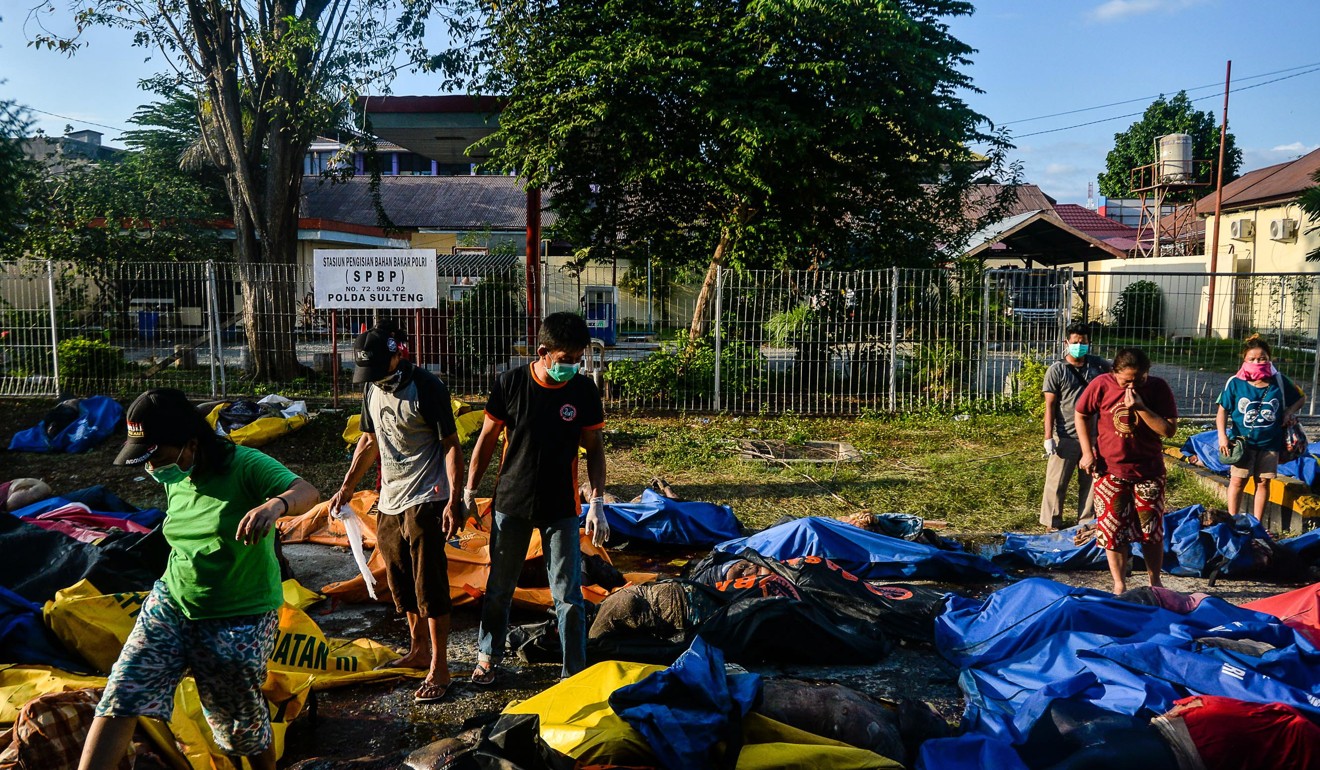
Indonesia tsunami: Sulawesi starts to bury its dead in mass, 100-metre-long graves
As a majority Muslim nation, religious custom calls for burials typically within one day
A mass burial for more than 1,000 earthquake and tsunami victims was being prepared in Sulawesi on Monday as heavy equipment rolled in to help dig for survivors of the disaster that struck the central Indonesian island three days ago.
The death toll, now at more than 840, is largely from the city of Palu and is expected to rise as areas cut off by the damage are reached. The magnitude 7.5 earthquake struck at dusk Friday and spawned a tsunami said to have been as high as 6 metres (20 feet) in places.
The grave being dug in Poboya – in the hills above the devastated seaside city of Palu – for hundreds of victims will be 10 metres by 100 metres (33 feet by 330 feet) in size and can be enlarged if needed, said Willem Rampangilei, chief of Indonesia’s National Disaster Mitigation Agency.
“This must be done as soon as possible for health and religious reasons,” he said.
Volunteer grave diggers were told to prepare for 1,300 victims to be laid to rest, Agence France-Presse reported.
Indonesia is majority Muslim, and religious custom calls for burials soon after death, typically within one day.

Military and commercial aircraft were delivering some aid and supplies to the region. But there was a desperate need for heavy equipment to reach possible survivors buried in collapsed buildings, including an eight-story hotel in Palu where voices were heard in the rubble. A 25-year-old woman was found alive on Sunday evening in the ruins of the Roa-Roa Hotel, according to the National Search and Rescue Agency, which released photos of the her lying on a stretcher covered in a blanket.
At least 832 people were confirmed dead as of Sunday evening, Indonesia’s disaster agency said, with nearly all of those from Palu. The regencies of Donggala, Sigi and Parigi Moutong – with a combined population of 1.2 million – had yet to be fully assessed.
Indonesian President Joko “Jokowi” Widodo toured Palu on Sunday and said rescuers were having difficulty reaching victims because of a shortage of heavy equipment.
“There are many challenges,” Jokowi said. “We have to do many things soon, but conditions do not allow us to do so.”
He said authorities were deploying more heavy machinery so emergency workers can help recover more victims Monday.
The stricken areas also needed medical supplies, fuel, fresh water and experts.
It was the latest natural disaster to hit Indonesia, which is frequently struck by earthquakes, volcanic eruptions and tsunamis because of its location on the “Ring of Fire,” an arc of volcanoes and fault lines in the Pacific Basin. In December 2004, a massive magnitude 9.1 earthquake off Sumatra island in western Indonesia triggered a tsunami that killed 230,000 people in a dozen countries. More recently, a powerful quake on the island of Lombok killed 505 people in August.

In Donggala, the site closest to the earthquake’s epicentre, aerial footage on local television showed some buildings had been swept out to sea, while others in town were severely damaged, with plywood walls shredded and chunks of concrete scattered on the pavement. Much of the damage, however, appeared limited to the waterfront.
Many people were trapped and buried under collapsed houses. I could do nothing to help
Palu, which has more than 380,000 people, was strewn with debris from the earthquake and tsunami. A heavily damaged mosque was half submerged and a shopping centre was reduced to a crumpled hulk. A large bridge with yellow arches had collapsed.
In one devastated area in Palu, residents said dozens of people could still be buried in their homes.
“The ground rose up like a spine and suddenly fell. Many people were trapped and buried under collapsed houses. I could do nothing to help,” resident Nur Indah said, crying.
“In the evening, some of them turned on their cellphones just to give a sign that they were there. But the lights were off later and the next day.”
Indonesia is a vast archipelago of more than 17,000 islands that span a distance that would stretch from New York to London. It is home to 260 million people. Roads and infrastructure are poor in many areas, making access difficult in the best of conditions.
The disaster agency has said that essential aircraft can land at Palu’s airport, though AirNav, which oversees aircraft navigation, said the runway was cracked and the control tower damaged.

